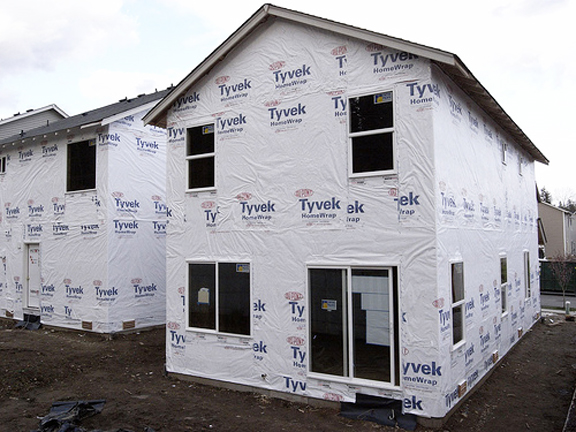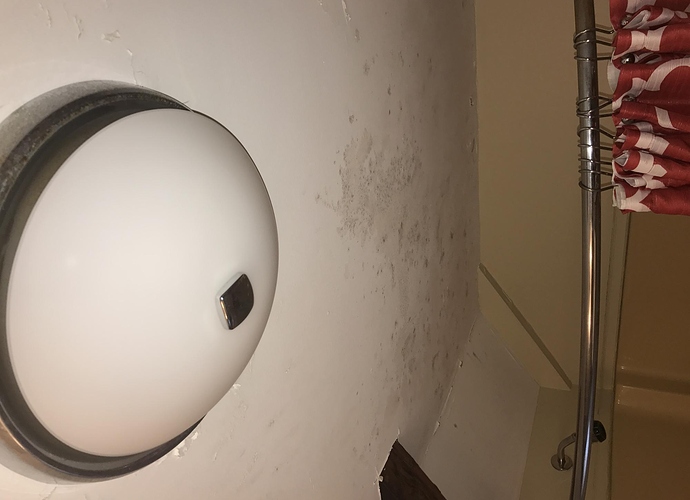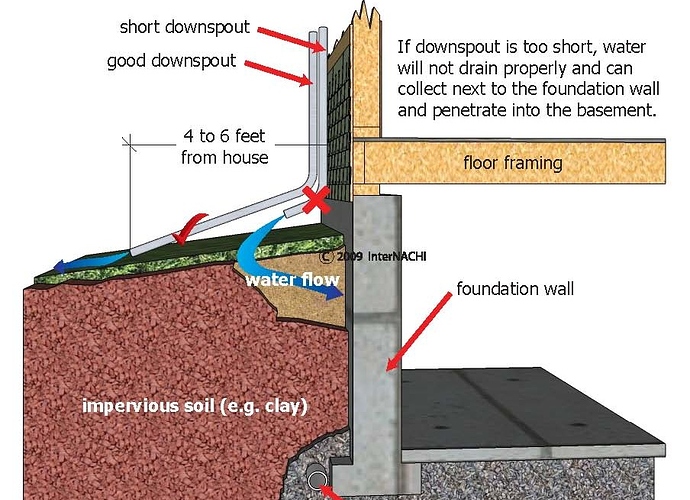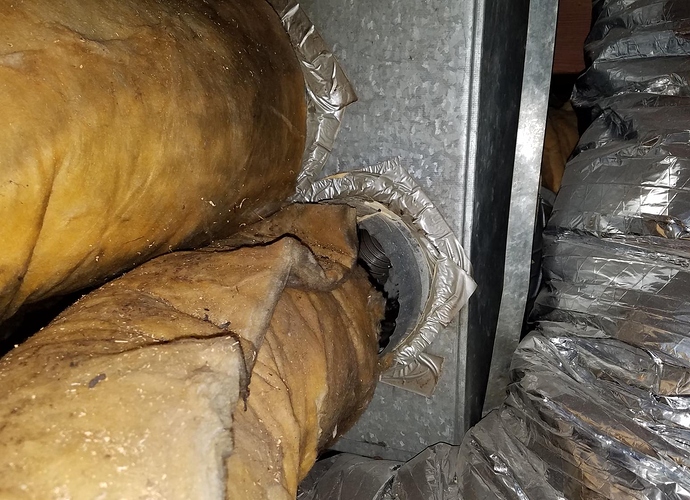I inspected a bathroom ceiling. I found what looks to be some microbial growth. The paint was peeling away from wood and the wood was a little soft to the touch. This should be repaired before more damage is caused.
In this picture you can see that several of the composite siding boards are beginning to rot because of moisture. By the time they reach this condition =, painting will not stop the process. They should be replaced.
I read the article on “Basic basement waterproofing”. I once finished out a basement of a 3 year old house. I did not know what if any treatments had been made to the exterior basements walls. We treated the interior walls with DryLock, attached Blue Board to the block walls then framed, insulated and sheetrocked. This method should reduce and condensation and help to insulate the basement.
[ATTACH][/ATTACH]
Picture from a home inspection showing lack of clearance from foundation to ground and the start of the siding
Doing inspections in a cold weather area, I have found it very important to look at the moisture intrusion especially where it concerns the vapor barrier to the warm side. There have been inspections where there have been double vapor barrier’s installed trapping moisture between them and causing a lot of moisture damage. Also it is very common in this area to vent an electric dryer to the conditioned basement area to add humidity during the heating months. This leads to moisture issues also
This house has many open penetrations that are allowing water and moisture to enter the home. All these holes should be properly caulked to prevent moisture from damaging the interior of the home. Some of these holes were drilled by utility companies to run wires. Some are also very close to grade level. Any flooding will definitely allow water to enter the home and do damage that may not been seen by the home owner.
Good course. I am working my way through this subject and have found that water damage and water intrusion are by far the most common problem in my brief inspection history. I am including a photo of a chimney chase cover that is made of galvanized metal and is showing signs of rust. On my inspection I noticed rust colored streaks on the inside of the chimney chase visible from an access in the attic. I found the galvanized cover had 3-4 very small holes through it that were allowing water intrusion. I recommended replacement.
My research assignment for this course is focused on the subject of mold. There has been a fair amount of press regarding mold and every once in a while there will be a news story about some poor family dealing with mold. Here is what I have learned.
Mold spores are everywhere. They float through the air and are part of our natural environment. They are necessary for the breakdown of organic matter in nature.
Some people have allergies to mold and therefore having mold in your house is not so good. Reducing the moisture content is the key as mold needs a damp place to take hold. Eliminate the moisture, thoroughly clean the affected areas and mold should not return.
Mold can sometimes grow in areas that not easily accessible and hard for a non-intrusive home inspector to locate. This problem will require the addition of a mold expert to locate and identify the source and mitigate the problem.
I found the article on Moisture Meters very interesting. Since mold can grow on surfaces with at least 20% moisture content, having a moisture meter to measure surfaces around the home is very beneficial. As an inspector a moisture meter can help identify if a house has leaks. Meters are also a great way to determine whether wood is dry enough to be painted or stained or if wood is dry enough to be installed.
Moisture Intrusion Essay
The attached photo shows a “sub-optimal” plumbing connection, found in a basement inspection recently. The cast iron drain pipe had a hole punched through the side, where a 2" pvc drain was inserted. The joint was then liberally smeared with mastic and called good. Needless to say, this joint is likely to fail at some point, potentially allowing wastewater and sewage to flow out into the basement. An approved fitting would have been a better option.
Inspecting with Thermal Imaging article
Thermal imaging is a technology which, along with a moisture meter, can be useful in inspecting homes for signs of roof leaks, pipe and plumbing fixture leakage, and other forms of moisture intrusion. Thermal imaging cameras can show moisture problems because they can see temperature differentials between dry and wet areas of the structure. Once a moisture issue has been identified by thermal imaging, a moisture meter can be used to confirm the finding.
Thermal imaging can also be useful in determining the source and/or extent of the moisture. Aside from a modest learning curve, there are few downsides to using thermal imaging, and many upsides.
Basement moisture issues often happen when planter boxes such as these are constructed next to the foundation. Be sure to pay close attention to the adjacent area of the basement for water damage.
The attached pictures shows an issue discovered on a recent inspection. There was some visible evidence of a leak or water pooling on an unfinished second floor. There was also so efflorescence of the masonry siding on the outside of the wall, which may or may not have been related. It is believed that the moisture intrusion was most likely from a small leak in the roof above. It was recommended to the potential purchaser investigate further and start with a roof inspection from the roofing contractor, as this roof was probably still under warranty.
For the article requirement of this course I read the article entitled “Commercial Water Towers” by Nick Gromicko. The article gave a brief explanation of what water towers are, how they are used and the history behind them. It then had a special section to talk about the water towers in New York City. At the end it gave a brief commentary on inspecting water towers.

There are many components that factor into the prevention of moisture intrusion into a home. The picture above shows the installation of “house wrap” on a home. These components must be properly installed and in the correct order as a home is built in order to ensure proper moisture control.



Another important component of handling water and moisture control/intrusion into a home is the gutter and downspout system. The picture above shows a downspout that is not long enough and allows water to empty next to the basement wall. It is important in this situation for an inspector to recommend that the extension be extended even further. The further water is taken from the home and the basement walls, the less likely it is that water will find its way through the basement walls.
The attached image shows an HVAC system in an attic with a disconnected duct. Not only will this reduce the efficiency and airflow of their HVAC system, but it will also introduce unwanted moisture into the attic. The duct should be reattached and taped to ensure an airtight seal.
The gallery illustration i found demonstrated how downspout extensions may not always be long enough. In the illustration, it shows water coming from and downspout and making its way back against the foundation wall. The picture then showed how a longer extension can keep the water away from the foundation wall and prevent moisture intrusion. I found it to be very helpful.
the following picture is of a hip wall in a very old home. this home was built in 1902 with a brick foundation. The hip wall was added sometime later. As you can see there is a significant erosion of the wall covering, which is a plaster. Under this plaster it is revealed that there is accumulation of effervescence. further inspection will indicate that there is a water leak coming from an old filled in coal chute. The coal chute should be sealed up, and the remaining damage cleaned up and inspected for other potential water leaks.
This is a short essay on moisture meters.
Moisture meters are very important to a home inspector. They can detect several potential issues, and help identify problem areas. Mold can begin to grow at aproximatly %20 moisture content. Keeping housing moisture below this level is important for keeping mold, fungus, and decay out of the home.
There are two types of moisture meters, the pin type and the search mode. Both meters are valuable in different ways.
The pin type gives a very easily recreated reading. It uses pins to penetrate into the wood to give a measurement.
The search mode type uses radio waves or electric current to determine moisture content. The waves will react differently when they encounter water, and the meter tracks that reaction. The meter can be skewed if there is metal present such as nails.










